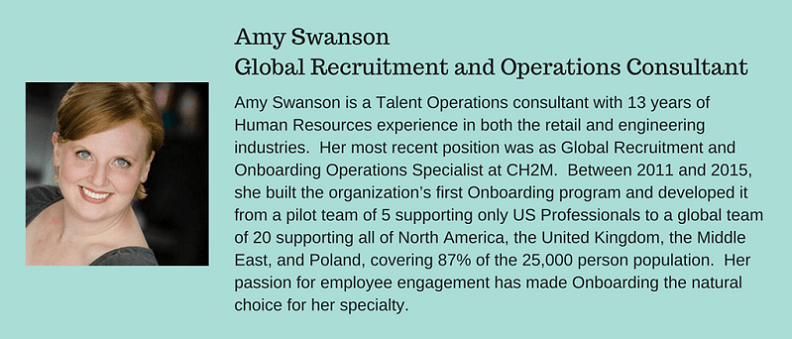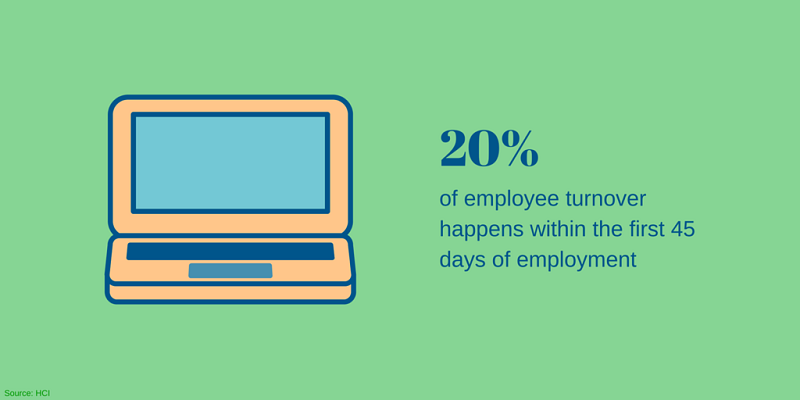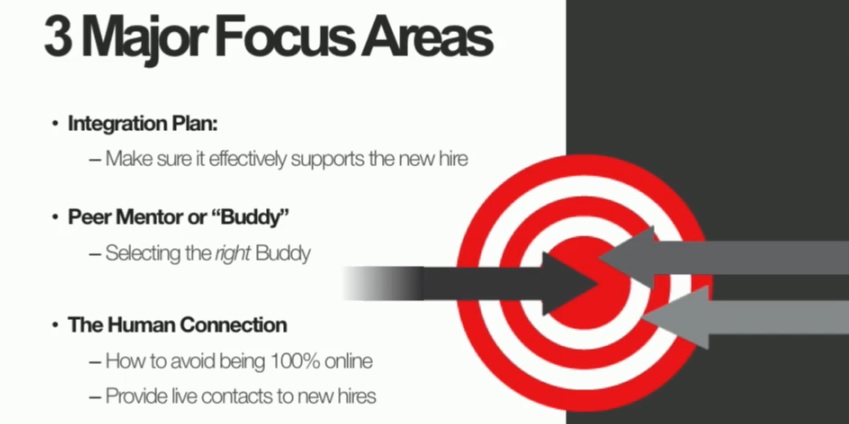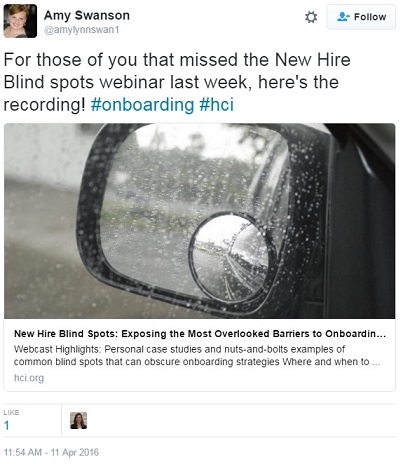Topics
How to Create an Engaging Onboarding Program: 10 Questions to Improve Employee Retention

CGS recently sponsored a Human Capital Institute webcast titled, ‘New Hire Blind Spots: Exposing the Most Overlooked Barriers to Onboarding Success.’ Elizabeth Woodward, CGS senior manager of learning programs, was joined on a panel by Amy Swanson, global recruitment and operations consultant, and Stephanie Bertmer, Hulu onboarding program manager.
Onboarding is a critical component to employee engagement, productivity and retention. The webcast covered onboarding tips, tricks and case studies as well as real-time audience input and questions. We received a number of insightful questions from our audience that we found valuable. Due to time constraints, however, we were unable to answer some of the questions that were posed by the attendees. So we followed up with one of our expert panel speakers to get some answers.

Our panelist Amy Swanson weighed in on the following webcast attendee questions:
What do you recommend to ensure that you’re providing a consistent, well-coordinated process yet also tailoring the content to different audiences and levels of experience (developers vs. leadership vs. call center agents?) –Kaiser06
You need to first build a base process that outlines what is needed for onboarding ALL employees in your organization. This should cover anything from set-up logistics, compliance needs, and trainings/company agreements to benefits and company perks.
Choose one population to integrate first. Identify and incorporate any additional needs that population needs and launch. Be very specific when you are selecting that population and if you are a global organization make sure it’s limited to one region.
Take the base process and things learned from your first implementation to create an Onboarding Assessment form for future integrations.
Here are a few important things to keep in mind:
- Do not try to implement the Onboarding process for all workers right off the bat. If you have multiple regions/populations to support, you may miss critical needs. Focus on building and testing the base process and first population.
- Try to focus on one implementation at a time. Take the time to properly assess the current population and needs to ensure that they are sufficiently supported.
- Partner with your Communications /HR teams to execute a communication plan. You will want to make sure everyone is on the same page before making any sort of announcements. This is twice as important when the new process is going to be integrated in phases.
What strategies do you recommend to get manager buy-in and SME participation? –Rtempleton
Show them how this will benefit them. The benefits vary between organizations but highlight any of the following that apply:
- There will now be one process that ensures nothing falls through the cracks and provides consistent experiences for the new hires.
- This will set up the new hire to succeed, and be up and running quickly. That adds to faster value to the company and job performance.
- Show stats or speak to the proven impact that proper onboarding has on turnover- if they don’t want to have to constantly be searching for someone rather than doing the job that they were hired to do, they need to set the hires up correctly and retain them.
- Standardizing a process should help set expectations with SMEs and identify Service Level Agreements and who is accountable for what.

How do you make your program more engaging for employees – how are you able to infuse "fun" into the information sharing and activities? –anonymous-8820
The key is engaging them. Making things fun for new hires includes doing things that have them actively participating.
An example would be during their Orientation. Start it out with ice breakers that require people to talk about themselves in a very neutral manner. One activity is to go around the room and have the new hire introduce themselves, their new job, and a personal fact (example):
- If you had the chance to go back to any place and time in history, where would you go?
- What song was in your head when you got up this morning?
- What would you be doing if you weren’t sitting here right now?
The key is to make it something that they have to think about but nothing that can be controversial – stay away from religion, politics, and world events. These can all end up causing an uncomfortable atmosphere.
When should onboarding "end"? What are the must-have milestones to make sure you’re on track? –Ada
I think a fair amount of time to complete all integration/onboarding activities is 60 days. Here is how I would break it down:
- Week 1 – Introduce:
- New Hire entry activities (right to work, paperwork, etc.)
- Meet manager/team/key contacts
- Manager to set expectations/share integration plan
- Month 1 – Acclimate:
- Complete all new hire activities/trainings
- Complete required benefits activities
- Build professional network
- Partner with colleagues to learn the job and take on tasks
- Begin goal-setting process
- Month 2 – Participate:
- Have full workload
- Research company’s developmental opportunities (internal/external training, tuition reimbursement, etc.)
- Understand company goals and where their work fits in
- Get integrated into projects
- Complete any outstanding Onboarding Activities
I highly recommend utilizing employee surveys - one after the introduce period and one at the participate level. This will tell you if things are going according to plan and if the tools you have are effective.
I'm curious to know what sort of tools, frameworks or communication plans you recommend creating for Managers and Onboarding partners? –anonymous-55531
I’m a big fan of checklists that are either online or have embedded hyperlinks so that the item can direct the user directly to the activity listed. The key to using these is make them succinct- it they are more than 2 pages long they won’t be used. If you need more space, try making a quick start guide- highlight the overall act and hyperlink it to the resource. Make sure that whatever is provided has a contact listed on it for questions.
What do you see as being the main difference between graduate onboarding and experience hire onboarding? –Ada
In my experience we have not treated them differently when Onboarding- they are all new hires. I do recommend to keep the tools you use up-to-date and fresh so that new employees entering the workplace can relate to it. An example is that if there is a new hire website or something similar, make sure social networking is well represented on it.
What metrics do you all use to evaluate success of an onboarding plan or cohort of people? –Rtempleton
One of the best metrics takes a lot of time and work- turnover rates. You can’t use this immediately because you need the program running for a few years to truly see if it is impacting voluntary turnover. To make this most efficient, you should have the voluntary term reasons broken down (relocation, retirement, salary, etc.) so you can see which would have been impacted by onboarding.
The other, more immediate tools to evaluate onboarding is to run surveys. I recommend running surveys for the new employees shortly after they start and after they have been in their job for a few months so that you can review the orienting experience against the integrated experience.
I have also used surveys to evaluate the process with hiring managers. Here’s the key with those- keep them short! I limited my survey to 6 multiple choice questions an open text box. The longer they are, the less likely they are to be completed.

Can you review the four areas of your Integration plan? –anonymous-5940
The four major focuses that all integration plans need to have are:
- Culture – Who are we as a company? What is our mission/values/goals? This is best when started with a statement that separates itself from the rest of the paragraphs so that it really stands out and gives the new hire a frame of mind with which to read the rest of the plan. A lot of the culture statements/about us information is usually skipped over to get to things that the new hire cares more about like benefits and pay. To really pull that hire into the culture, a powerful purpose statement will help.
- Network – Where does your business group/team/role fit into the organization? Who are the key contact that you need to have? Be sure, when listing key contacts that you include their full name, job title, business group (if different than the BG of the new hire), and their contact information. If you want your hire to schedule meetings with them it’s a good idea to include their assistant (if applicable) and the priority of the meeting.
- Expectations – What are the major priorities that this hire needs to work on? What time frame do they need to be aware of? What is the impact on the company? How do you like to be communicated with as their manager? What kinds of regular meetings do they need to make time for? Anything that will set your hire up with a solid understanding of what is expected of them.
- Resources – This section should have any specific resources that the hire will need. This can include:
- Contact information for administration groups or call centers (Payroll, HR, Facilities, etc.)
- Links to important websites or resources
- Floor plans with fire exits, evacuation plans, and medical stations
- Emergency/ethics/healthcare hotlines
- How to use the shared office equipment
It can really be anything that would support your new hire. Think of what you needed or wish you had handy when you started a new job and let it guide you.
What tips do you have overcoming corporate 'silos' through onboarding process? And with a company that has many divisions, branches, stores, how important is it to expose them to all areas in the onboarding process? –KateSH
The more important thing to align all the divisions and locations to the brand. Once that is established, onboarding can fall into that brand which will lead to a more natural acceptance across the board.
After this (or in lieu of this if the branding is not an option at that time), the best way to get everyone on the same page create a centralized resource, get it well known to the management of the different groups, and then govern its use.
To centralize, utilize an internal source where major company information is shared – it could be an intranet site or even a bulletin board. Keep tools and resources such as integration plan templates, checklists, FAQs, etc. and either hyperlink to them or maintain them there. The key is to make sure they are up to date and available.
Next, publicize because people aren’t going to use things that they are not aware exists. This would entail working with your HR or Communications teams to build out the appropriate plan.
Finally, find ways to govern that these tools are actually being utilized. The best way to ensure this is through new hire feedback. I strongly suggest utilizing surveys with specific, leading questions that really zero in on the particular tool. The results of this can show the success of the effort and measure the effectiveness off the tools.
Revenue generating activities always come first. How do you justify building out an onboarding process? –Rtempleton
There are a couple of ways to justify Onboarding from a financial perspective:
- Identify your cost per hire and compare it to the voluntary turnover rates of the company. Since in this scenario the program has not launched yet you can’t look at impact statistics for your company, however, you can look up professional reports where other companies can show the financial impacts.
- Lay the current plan out piece by piece. The team I worked with actually got a conference room and assigned each team involved in the pre-onboarding process a different color. We received post-it pads of our individual color and were told to write each step that our groups performed to add to a timeline hung up on the wall. In my experience, the duplication and confusion was amazing. Right there, in living color, we could all see where there was waste and where there were things missing. This activity can illustrate the following to any management:
- Duplication – this was due to no one owning the task so multiple people attending to the same task- streamlining leads to financial savings
- Waste – could be in the form of physical waste or people doing steps that didn’t need to be done because no one had full visibility to the process and therefore couldn’t see when waste happened. Less physical and work time waste leads to financial savings
- Confusion – a perfect combination of duplication and waste – can lead to multiple people performing the same task or nobody performing the task. Understanding the negative impact of duplication, the problems resulting from something falling through the cracks will result in additional financial savings.
They key is in more than just these general justifications. You will need to do the math – see how much money is wasted in both physical and human resources and then create a business case for your onboarding program against that loss.
Thank you to all those who attended our webcast and participated to make it a great session. If you missed it, or would like to review the presentation again, please download the ‘New Hire Blind Spots: Exposing the Most Overlooked Barriers to Onboarding Success’ on-demand recording. If you have any additional questions, feel free to reach out to us on Twitter @LearningCGS.


